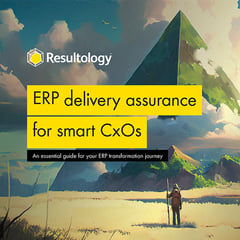And the Awards for the Most Successful SAP Customers go to...
All large and medium-size enterprises today are trying their hardest to stay ahead of their competition by using a range of different business strategies. This has been made all the more difficult by the Covid-19 pandemic. For most of them, looking after the customer has become a passion, not a luxury.
We all have to try harder to look after our customers, our employees and the environment, not just to increase efficiency, but because we all know that it is the right thing to do. Digital technologies are key to this. Research shows (Ref 1) that enterprises that have successfully undergone a business transformation using digital capabilities perform better, with a 16% higher margin than their industry average.
But to do this, a clear prerequisite is a highly efficient back office, with systems of record handling core business processes. All SAP customers work hard to achieve this - to become what SAP calls an Intelligent Enterprise. Previous research has established several proven SAP best practices that differentiate the best from the rest. As a result, the best SAP customers are simply more successful, so they in turn can help their own customers to become more successful. But what do these ”Most Successful SAP Customers” really look like today?
A model for SAP Customer Success
As we have seen, large integrated Enterprise Resource Planning (ERP) and Supply Chain (SC) projects are just that – large, highly integrated and complex. In spite of that there are thousands of examples of SAP customers who have been extraordinarily successful and made major savings, experienced huge business benefits or transformed their businesses. At the same time, unfortunately, there are also examples of SAP (and all other leading enterprise applications vendors) customer projects that have gone wrong and hit the headlines.
But - if we are dealing with exactly the same application software product - why is this?
Well, we know that there are leaders and followers in every industry, so does this explain why some customers are more - or less - successful? After three decades of experience with ERP you would think that all the best practices have been uncovered and all the lessons learned to make failure completely avoidable, wouldn’t you?
To try to unravel the secrets of SAP customer success, an innovative research project (Ref 2) by Resulting IT in the UK surveyed over 100 experienced SAP customers to determine exactly how successful their overall SAP program and projects had been to date.
The premise of this research is that overall SAP customer success can be defined as follows:

In a highly complex world, the meaning of On Plan and On Budget maybe obvious, but they can be incredibly challenging to achieve. But CEOs know that is not enough. We also have to be On Value to the CEO in order to be truly successful. This means that the SAP program has to deliver the business value laid out in the original business case.
Now let’s see what those award-winning successful SAP customers have actually achieved.
On plan: the SAP program keeps to the original delivery plan
This is a primary focus of the CIO. Having been live on SAP ERP & SC as their systems of record for many years there has never been any unplanned SAP system downtime for the business at all. The very experienced CIO knows the underlying complexity of the SAP systems and runs them on infrastructure with no single points of failure, maximum reliability and a well-rehearsed business continuity plan. On top of this, highly experienced SAP support staff manage the landscape of SAP systems, using software tools to automate their operation. There have never been any security breaches.
After the first go-live there has always been an SAP Centre Of Excellence (CoE) in place to retain core SAP product knowledge, maintain governance, collaborate with all parts of the business and manage external service providers. Each year the business funds a series of rollout and improvement projects, all of which have been delivered to plan. The CoE, with its automated application testing team, plus a separate Project Management Office (PMO) are key to this project success.
On budget: the SAP program delivers to the original budget
This is a primary focus of the CFO. SAP programs are usually associated with high TCO, so the CFO has always maintained an SAP lifecycle plan to avoid unexpected costs, especially for upgrades. An S/4HANA transition is part of this plan. The self-sufficiency provided by the SAP CoE has always kept a lid on SAP OpEx running costs and CapEx project build costs.
To stay on budget as the business grows into new areas the CFO is exploring the Pay As You Go claims of the hybrid cloud delivery model, including private and public cloud (hyperscaler) platforms with managed service providers. Reducing up-front CapEx costs is very desirable, but unexpected OpEx costs are not. The CFOs research has uncovered negative as well as positive experiences about this IT consumption-based pricing method amongst other CFOs in her peer network.
On value: the SAP program delivers the business value in the business case
This is a primary focus of the CEO in board meetings. The CEO has worked at a number of other SAP customers and has picked up invaluable experience along the way. As a result, a board member always acts as the executive sponsor for the SAP program. The CIO is tasked with ensuring that IT is totally business-driven and a formal ERP Strategy document defines the business processes and governance principles of all back office systems. It also includes KPIs for measuring process efficiency.
All SAP projects over a certain size require a formal business case to define the business value expected and the business process owners try hard to measure this after go-live. The CEO has instigated programs within the business units to boost end user adoption (Ref 2), in order to squeeze more value over the longer term.
On plan + On budget + On value = SAP Customer Success
So, the most successful SAP customers are those that understand the vital Success Levers (Ref 2) that are required to be On plan, On Budget and On value. All of them deserve an award.
It is no coincidence that in February 2020 SAP embarked on its biggest ever internal reorganization to refocus on its customers. SAP gathered all of its customer-facing teams into a new global unit, called Customer Success, with the clear aim of developing a shared definition of Customer Success with customers and helping them to achieve their strategic business outcomes.
We all know that just one month after this announcement the Covid-19 global pandemic struck, with devastating consequences. Since then, we have all had to adapt to remote working practices, and in spite of that some amazing global SAP projects have been successfully delivered.
Today, many large and medium-size enterprises are on a digital transformation journey to streamline their business models and generate new revenues. To do this they must build on top of their successful SAP back office programs to introduce new differentiating layers of exciting new technologies. If they are successful they will be nominated for even more awards…
References
• Ref 1: MIT CISR research note, “Future Ready? Pick Your Pathway For Digital Business Transformation”, available at, https://cisr.mit.edu/blog/documents/2017/09/21/2017_0901_digitalpathways_weillwoerner.pdf/, requires a login.
• Ref 2: Resulting IT research report, “SAP Success Report 2018: Uncovering the factors that drive success for SAP customers”, available at, https://resulting-it.com/how-to-run-a-succesful-SAP-implementation-sap-consultancy .











